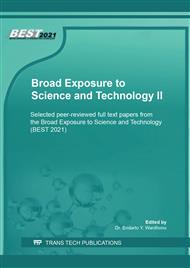[1]
J. Zhang, S. Shen, Y. Cheng, H. Lan, X. Hu and F. Wang, Dual lixiviant leaching process for extraction and recovery of gold from ores at room temperature, Hydrometallurgy. (2014) 114–23.
DOI: 10.1016/j.hydromet.2014.02.001
Google Scholar
[2]
Li, J., Safarzadeh, M., Moats, M., Miller, J., LeVier, K., Dietrich, M., & Wan, R, Thiocyanate hydrometallurgy for the recovery of gold, Hydrometallurgy. 113-114 (2012) 10-18.
DOI: 10.1016/j.hydromet.2011.11.007
Google Scholar
[3]
Z. Dong, T. Jiang, B. Xu, Y. Yang and Q. Li, Recovery of gold from pregnant thiosulfate solutions by the resin adsorption technique, Metals. (2017) 1–17.
DOI: 10.3390/met7120555
Google Scholar
[4]
P. Navarro, C. Vargas, M. Alonso, and F.J. Alguacil, The adsorption of gold on activated carbon from thiosulfate-ammoniacal solutions, Gold Bull. (2006 ) 93–7.
DOI: 10.1007/bf03215535
Google Scholar
[5]
Ma, C.J., Li, J.Y., & Liu, R.J. (2015), A review of thiocyanate hydrometallurgy for the recovery of gold, Applied Mechanics and Materials. 768 (2015) 53–61.
DOI: 10.4028/www.scientific.net/amm.768.53
Google Scholar
[6]
O. Barbosa-Filho and J. Monhemius, Leaching of gold in thiocyanate solutions. Part 1 : chemistry and thermodynamics, Transactions Institution of Mining & Metallurgi. (1994) 105–110.
Google Scholar
[7]
J. Monhemius and S.P. Ball, Leaching of dominican gold ores in iodide-catalysed thiocyanate solutions. Trans Instn Min Met (sect C Miner Process Extr Met). (1995) 117–24.
Google Scholar
[8]
J. Li, M.S. Safarzadeh, M.S. Moats, J.D. Miller, K.M. Levier, M. Dietrich and R.Y. Wan, Thiocyanate hydrometallurgy for the recovery of gold. Part IV : Solvent extraction of gold with Alamine 336, Hydrometallurgy. (2012) 25–30.
DOI: 10.1016/j.hydromet.2011.11.006
Google Scholar
[9]
O.N. Kononova, A.G. Kholmogorov, N.V. Danilenko, S.V. Kachin, Y.S. Kononov, Zh.V. Dmitrieva, Sorption of gold and silver on carbon adsorbents from thiocyanate solutions, Carbon. (2005) 17–22.
DOI: 10.1016/j.carbon.2004.08.021
Google Scholar
[10]
J. Li, M.S. Safarzadeh, M.S. Moats, J.D. Miller, K.M. Levier, Dietrich and R.Y. Wan, Thiocyanate hydrometallurgy for the recovery of gold. Part I : Chemical and thermodynamic considerations, Hydrometallurgy. (2012) 1–9.
DOI: 10.1016/j.hydromet.2011.11.005
Google Scholar
[11]
F.R. Mufakhir, W. Astuti, E. Purwaningsih, E. Prasetyo, S. Sumardi, Sudibyo, A.S. Handoko, A. Junaedi, N.M. Prilitasari, Y.I. Supriyatna, Characterization of gold ore from Tanggamus mine Lampung Province, IOP Conf Ser Mater Sci Eng. (2019) 1-7.
DOI: 10.1088/1757-899x/478/1/012018
Google Scholar
[12]
G.W. Kajjumba, S. Emik, A. Öngen, H.K. Özcan and S. Ayd, Modelling of adsorption kinetic processes — errors , theory and application. in: advanced sorption process applications, 2019, p.1–19.
DOI: 10.5772/intechopen.80495
Google Scholar
[13]
F.R. Mufakhir, J.M. Sinaga, S. Oediyani and W. Astuti, Pelarutan Emas pada Pelindian Konsentrat Emas Hasil Roasting, Jurnal Rekayasa Proses. (2019) 24–30.
DOI: 10.22146/jrekpros.41519
Google Scholar
[14]
I.J. Corrans, J.E. Angove, Ultra fine milling for the recovery of refractory gold, Minerals Engineering. (1991) 763–76.
DOI: 10.1016/0892-6875(91)90064-3
Google Scholar
[15]
J.A. González-Anaya, F. Nava-Alonso, E.T. Pecina-Trevino, Gold recovery optimization of a refractory concentrate by ultrafine grinding – a laboratory study, Miner Metall Process. (2011) 94–101.
DOI: 10.1007/bf03402394
Google Scholar
[16]
H. Marsh, F. Rodriguez-reinoso, Activated Carbon, first ed., Elsevier Science, (2006).
Google Scholar
[17]
R. Tsolele, F.M. Mtunzi, M.J. Klink, An alternative low-cost adsorbent for gold recovery from cyanide-leached liquors : Adsorption isotherm and kinetic studies (2018).
DOI: 10.1177/0263617418802557
Google Scholar


